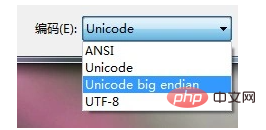 WARNING
WARNING
This article only explains the technical facts of a widely used software and does not mean that the author supports or opposes the use of the software.
In fact the author recommends never using Windows Notepad to work with computer program code at any time.This article is only verified on a certain instance of the Simplified Chinese version of 64-bit Windows 7 and is for reference only. There is no guarantee that consistent results can be reproduced on other identical or dissimilar systems.
Note
This article strictly distinguishes between Unicode's
and
byte serialization. Unicode's Encoding only refers to the work of using numbers (usually written as hexadecimal numbers) to represent characters one-to-one. The range of this number is restricted only by the Unicode standard and has nothing to do with computers. Unicode's
Byte serialization refers to the work of representing a number within the Unicode standard range into N bytes in order to be able to be written into computer memory.
Test caseThe test case is: "锟斤拷[line break]a[line break]". (Kun Jin Kao is a belief.)
The GBK and Unicode encodings of all characters are:
锟GBK=EFBF
Unicode=- U 951F
-
金GBK=BDEFUnicode= U 65A4 -
copyGBK=BFBDUnicode= U 62F7 -
The GBK and Unicode encodings of the following ASCII characters are consistent with ASCII:
0x61
CR=0x0DLF=
Under the Simplified Chinese system, ANSI is the GBK encoding defined by the national standard of the People's Republic of China.0x0A(One newline character in Windows occupies two characters: CR LF)ANSI
The result of Windows Notepad using ANSI to store this file is as follows:
EF BF BD EF BF BD 0D 0A 61 0D 0A ----- ----- ----- -- -- -- -- --
Simply use GBK encoding to store all characters. A single byte with the highest bit not being 1 and equivalent to ASCII, otherwise a double byte.
We should pay attention to the issue of byte order (Endian) here
[Note A]. You can see that the byte order here is
big-endian. But there is no need to specifically emphasize "GBK with big endian first" - because starting from GB2312, the standard stipulates that the storage method is big endian first[Note B]. Later GBK is backward compatible with GB18030-2000.
The trouble with ANSI is that it depends on the system - ANSI of other language systems is not GBK, and files opened in GBK will inevitably be garbled. And the character set of GBK itself is too small. (Never say "I only use Chinese" - without the symbols of Unicode, the emojis on the Internet cannot be typed)
What Windows Notepad said "Unicode", "Unicode big endian" and UTF-8 are all different
storage methods of the same Unicode
encoding. UTF-16 and BOMUnicode here refers to UTF-16
[Note C]. UTF-16 is an extremely simple and crude serialization method - most Unicode characters are in the range of U 0000 ~ U FFFF
[Note D], then each character uses two bytes , write the original value of Unicode encoding to disk. Note that ASCII characters must also waste twice the space to store the upper 8 bits of 0x00 - because if the upper 8 bits of 0 are omitted, there will be no other basis for hyphenation during parsing. For UTF-16, there are big-endian and little-endian problems - UTF-16 does not specify whether the byte is big-endian or little-endian first. But UTF-16 does not contain information indicating byte order. You can't manually check which parsing is not garbled...
The solution provided by Unicode is to convert a
zero-width unbreakable After the character space character(
U FEFF ZERO WIDTH NO-BREAK SPACE) is serialized in UTF-16, it is stuffed at the front of the file. In this way, the UTF-16 parser reads the first two bytes of the file. If it is FE FF, it means big end first, and FF FE means little end first. This stuffed thing is called BOM (Byte Order Mark, byte order mark).
Zero-width non-hyphenation space character
is also often used as a valid character to break the word limit in various situations. Includes SegmentFault's Q&A and comments.encoding"Unicode" and "Unicode big endian" in Notepad
Writing "Unicode" alone is not a complete expression of a storage method at all. Because this only contains
and not
byte serialization. M$出现这种错误,我一点都不觉得奇怪。死记结论就可以了:Windows Notepad的“Unicode”就是UTF-16。 Windows Notepad使用“Unicode” = 小端在先的UTF-16,存储这个文件的结果如下: FF FE 1F 95 A4 65 F7 62 0D 00 0A 00 61 00 0D 00 0A 00
-BOM- ----- ----- ----- ----- ----- ----- ----- -----
U+FEFF 951F 65A4 62F7 000D 000A 0061 000D 000A <p>Windows Notepad使用<strong>“Unicode big endian” = 大端在先的UTF-16</strong>,存储这个文件的结果如下:</p><pre class="brush:php;toolbar:false"> FE FF 95 1F 65 A4 62 F7 00 0D 00 0A 00 61 00 0D 00 0A
-BOM- ----- ----- ----- ----- ----- ----- ----- -----
U+FEFF 951F 65A4 62F7 000D 000A 0061 000D 000A <h3>UTF-8</h3><p>UTF-8是一种用1~4个字节表示1个Unicode字符的<strong>变长的</strong>字节序列化方法。具体的实现细节看这篇文章。UTF-8的好处在于:</p><ol>
<li>无论是IETF的推荐,还是实际业界的执行,UTF-8都是互联网的标准。</li>
<li>向下兼容,ASCII字符UTF-8序列化后仍是原样,任何ASCII文件也是有效的UTF-8文件。</li>
<li>没有字节序问题。UTF-8的字节序是由RFC3629定死的。</li>
</ol><p>Windows Notepad使用UTF-8存储这个文件的结果如下:</p><pre class="brush:php;toolbar:false"> EF BB BF E9 94 9F E6 96 A4 E6 8B B7 0D 0A 61 0D 0A
--BOM--- -------- -------- -------- -- -- -- -- --
U+ FEFF 951F 65A4 62F7 000D 000A 0061 000D 000A <p>注意UTF-8前边仍然塞进去了<code>U+FEFF</code>按照UTF-8序列化的结果<code>EF BB BF</code>,作为前边提到过的<strong>BOM</strong>字节顺序标记。<strong>Windows Notepad存储的UTF-8,是带有BOM标记的UTF-8</strong>。</p><p>但是如果仅仅对于UTF-8而言,字节序是没有意义的。因为UTF-8的字节序被规范写死,<code>U+FEFF</code>编码后必然得到<code>EF BB FF</code>,得不出其他的。没有二义性,BOM就失去了原本的意义。也许只有区别UTF-8文件和UTF-16文件的用处……</p><p>如何对待UTF-8文件的BOM,RFC3629的第6章有详细的规定,不加详述。</p><p>值得一提的是,BOM我想很多PHP程序员都经历过并且恨之入骨——PHP不认识文件中的BOM头并会将其作为HTTP Response的正文送出。这甚至在无缓冲的情况下,会导致<code>header()</code>等必须在Response开始前执行的函数直接失效。</p><p>所以PHP程序员总是会喜欢<strong>UTF-8 without BOM</strong>的编码方式——这基本也就宣布了Windows下的PHP开发,Windows Notepad完全的淘汰出局,哪怕是任何一星半点代码的临时修改。</p><h2>番外:Notepad++的字符编码测试</h2><p>ANSI没有区别,但Notepad++支持选择多国编码的不同ANSI编码方式(类似浏览器里选编码),可以轻松生成或读取Shift-JIS等其他字符集的文件。适合用于对付日文老游戏的<code>README</code>等文档。</p><p>UCS-2 Big Endian、UCS-2 Little Endian和前边UTF-16的两个例子一致。注意UTF-16的文件不提供“无BOM”的存储方法(提供了就坏了)。</p><p>UTF-8仍然代表“带有BOM标记的UTF-8”。但同时提供PHP程序员最爱的UTF-8 without BOM,就像:</p><pre class="brush:php;toolbar:false"> E9 94 9F E6 96 A4 E6 8B B7 0D 0A 61 0D 0A
-------- -------- -------- -- -- -- -- --
U+ 951F 65A4 62F7 000D 000A 0061 000D 000A <p>Simple and clean.</p><blockquote><p><strong>注解</strong><br><code>[注A]</code> 对于一个双(多)字节的数,一定会按8位截断为1字节后写盘。那么写盘时先写最低8位还是先写最高8位,就是所谓的“字节序”(Endian)问题。例如,数<code>0x01020304</code>写盘时,是先写最低8位的<code>04 03 02 01</code>,还是先写最高8位的<code>01 02 03 04</code>?<br>
先写低8位的叫做小端在先(little-endian),先写高8位的叫做大端在先(big-endian)。实际采用何种字节序受系统环境、标准规范和软件实际编写的多方面控制,不一概而论。<br><code>[注B]</code> 字节序如果我没弄错,是GB2312采用的EUC字符编码方法控制的。<br><code>[注C]</code> 本文并不严格区分<strong>UTF-16</strong>与<strong>UCS-2</strong>。<br><code>[注D]</code> Unicode的最大值实际上达到了U+10FFFF,超出了两个字节能够存储的限度。<br>
但Unicode由于历史原因,留下了U+D800~U+DFFF这一段永久保留不用的空缺区域。<br>
因此对U+10000及以上的字符,UTF-16借助了这部分空缺区域,对这些编码超大的字符打破2字节16位的惯例,特别的用4字节32位去表示之。<br>
这一部分编码值太大的字符,超出了GBK的字符集范围,因此本文将<strong>完全忽略</strong>。如有机会再进一步测试</p></blockquote>



